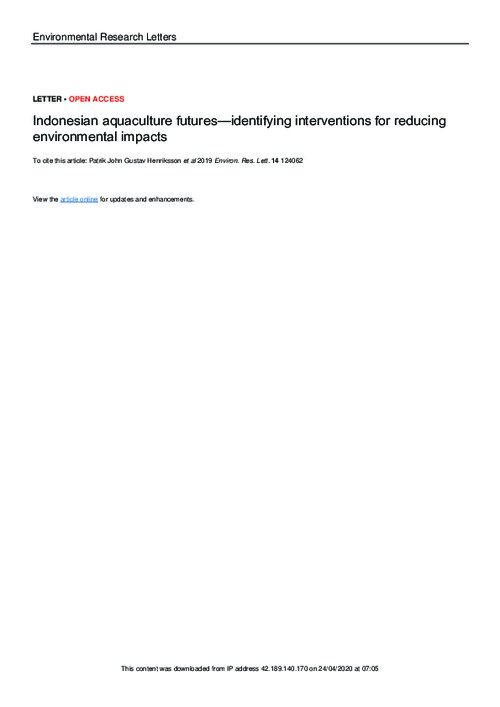Please use this identifier to cite or link to this item:
https://hdl.handle.net/20.500.12348/3827
Indonesian aquaculture futures — identifying interventions for reducing environmental impacts
| dc.creator | Henriksson, P.J. | en_US |
| dc.creator | Banks, L. | en_US |
| dc.creator | Suri, S. | en_US |
| dc.creator | Pratiwi, T. | en_US |
| dc.creator | Ahmad Fatan, N. | en_US |
| dc.creator | Troell M. | en_US |
| dc.date.accessioned | 2019-12-04T19:38:21Z | |
| dc.date.available | 2019-12-04T19:38:21Z | |
| dc.date.issued | 2019 | en_US |
| dc.identifier.citation | Patrik Henriksson, Lauren Banks, Sharon Suri, Trini Pratiwi, Nurulhuda Ahmad Fatan, Max Troell. (7/10/2019). Indonesian aquaculture futures — identifying interventions for reducing environmental impacts. | en_US |
| dc.identifier.issn | 1748-9326 | en_US |
| dc.identifier.uri | https://hdl.handle.net/20.500.12348/3827 | |
| dc.description.abstract | Indonesia is the world's second largest producer and third largest consumer of seafood. Fish is thus essential to the nation, both financially and nutritionally. Overfishing and the effects of climate change will, however, limit future capture fisheries landings, so any increases in future seafood production will need to come from aquaculture. Aquaculture's ecological effects are dependent upon the choice of species, management, and where it is sited. In the present study we use Life Cycle Assessment (LCA) to evaluate how possible interventions and innovations can mitigate environmental impacts related to the aquaculture sector's growth. | en_US |
| dc.format | en_US | |
| dc.language | en | en_US |
| dc.publisher | IOP Publishing | en_US |
| dc.rights | CC-BY-4.0 | en_US |
| dc.source | Environmental Research Letters;(2019) | en_US |
| dc.subject | lca | en_US |
| dc.subject | seafood | en_US |
| dc.subject | coral | en_US |
| dc.subject | mangrove | en_US |
| dc.subject | Fish | en_US |
| dc.title | Indonesian aquaculture futures — identifying interventions for reducing environmental impacts | en_US |
| dc.type | Journal Article | en_US |
| cg.contributor.crp | Fish | en_US |
| cg.contributor.funder | Walton Family Foundation | en_US |
| cg.contributor.project | Indonesian Aquaculture Futures 2018-2030 - Developing recommendations for an Alternative Aquaculture Development Plan for 2030 based on an assessment of the suitability of coastal marine habitats and input requirements | en_US |
| cg.coverage.country | Indonesia | en_US |
| cg.coverage.region | South-Eastern Asia | en_US |
| cg.subject.agrovoc | land use | en_US |
| cg.subject.agrovoc | sustainability | en_US |
| cg.contributor.affiliation | Stockholm Resilience Centre | en_US |
| cg.contributor.affiliation | Independent / Not associated | en_US |
| cg.contributor.affiliation | WorldFish | en_US |
| cg.identifier.status | Open access | en_US |
| cg.identifier.ISIindexed | ISI indexed | en_US |
| cg.contribution.worldfishauthor | Suri, S. | en_US |
| cg.contribution.worldfishauthor | Pratiwi, T. | en_US |
| cg.contribution.worldfishauthor | Ahmad Fatan, N. | en_US |
| cg.description.theme | Sustainable aquaculture | en_US |
| dc.identifier.doi | https://dx.doi.org/10.1088/1748-9326/ab4b79 | en_US |
| cg.creator.id | Patrik John Gustav Henriksson: 0000-0002-3439-623X | en_US |
| cg.creator.id | Sharon K Suri: 0000-0003-3064-7991 | en_US |
Files in this item
This item appears in the following Collection(s)
-
Sustainable aquaculture [2717]
